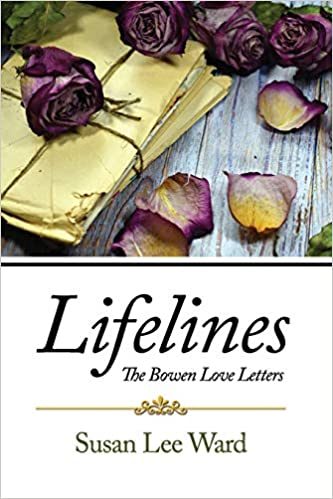A silver lining is a metaphor for optimism, which means a negative occurrence may have a positive aspect to it. In every bad situation, there is an element of good, a blessing in disguise.
EVERY CLOUD HAS A SILVER LINING – “John Milton’s 1634 masque (dramatic entertainment) ‘Comus’ gave rise to the current proverb with the lines, ‘Was I deceiv’d, or did a sable cloud/ Turn forth her silver lining on the night?’
Charles Dickens, in his 1853 novel ‘Bleak House,’ recalled the lines with ‘I turn my silver lining outward like Milton’s cloud.’
The American impresario Phineas T. Barnum in 1869 first recorded the wording of the modern saying in ‘Struggles and Triumphs.’ “Every cloud,’ says the proverb, ‘has a silver lining.”
Citation: “Wise Words and Wives’ Tales: The Origins, Meanings and Time-Honored Wisdom of Proverbs and Folk Sayings Olde and New” by Stuart Flexner and Doris Flexner (Avon Books, New York, 1993).
In Lifelines – The Bowen Love Letters, Katie Bowen broke her left leg in several places, lacerating her skin, and severely sprained her ankle as well. She had immediate medical care, but of course, x-rays and other imaging techniques were not available in 1852 at Fort Union, New Mexico Territory! Katie’s accident resulted in a comminuted fracture – a fracture in which a bone is broken, splintered, or crushed into a number of pieces. She was an optimist and worked diligently for several years with a variety of physicians, a wise Pueblo women, and a French bone setter. Remedies tried included hot salt and vinegar rubs, hot water washes, cold water washes, cloth and plaster bandages, liniment, pepper washes, and juniper bark washes to reduce the swelling in her ankle and regain strength in her leg. She always looked for the silver lining and I think for her, it was learning patience, and letting those around her help with physical needs, childcare for her baby, and household management.
For those of you new to my blogs about Lifelines – The Bowen Love Letters, I almost always include pertinent letters written by Katie Bowen and her husband, Captain Isaac Bowen, for context.
October 3, 1852 Fort Union, New Mexico Territory
Dear Father and Mother Cary,
From seeing my writing, you will probably apprehend that something is amiss with Katie and such is the case. She is confined to her bed with a broken leg. For the circumstances of the accident, read on. Last Monday morning the 27th of September, I had had my mule harnessed early, intending to drive to Rayado with Dr. Byrne (Captains Shoemaker and Sykes being in another carriage) after some plums for preserving. We had breakfasted and Katie had stepped into the kitchen with Willie in her arms to see that “lunch” was properly packed for us. I was putting some things in the carriage about twenty-five yards from the kitchen door when I heard a fearful succession of groans from her. I turned and saw her lying on her back, holding the boy still in her arms. In stepping from the kitchen, her foot slipped on the edge of a small trench dug to conduct the water when it rains, and she had fallen forward striking her elbows. In this condition she could not recover herself without dropping Willie, and she turned to her right to sit down. In doing so, the toe of her left foot caught in the perpendicular bank of the narrow trench and snapped the bone of the leg in two places near the ankle under the old scar and the shin bone about midway between the knee and ankle. Doctor Byrne was soon in attendance and dressed and set the leg.
The swelling has been great, but that was to be expected as she is so fleshy and plethoric and the flesh was considerably lacerated by the sharp edges of the broken bone. The boy was not hurt a particle and has been the best child that ever was since his mother was hurt. Katie has suffered a good deal more from nervousness, however, than pain. She has not had the bandages removed yet, and has not moved her body an inch except involuntarily. The doctor has been devoted in his attention, as well as all the good people, our friends here. The doctor told me after visiting her this morning that I might assure you that she was getting on well, that she was without fever and that the swelling and inflammation of the leg were subsiding. He has this morning given her some pills to operate the bowels, which have not been moved since the morning she was hurt. You may be sure that she has every care and attention that is possible to bestow, but still it is very trying to her patience and endurance to be unable to move or be moved, even with assistance, for so long a time. I have had to administer “morphia” to her occasionally to quiet her nerves and let her sleep. Yours affectionately, Isaac
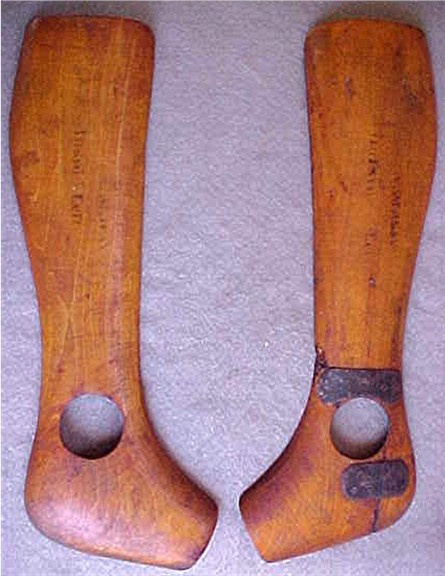
October 15, 1852 Fort Union, New Mexico Territory
Dear Father and Mother Cary,
I wrote to you on the 3rd of October giving you an account of the accident that had happened to Katie and of her condition at that time. The injury proves to have been greater than was at first imagined, in some respects. The ankle suffered a violent sprain and has been, as well as the limb, very much swollen. The inflammation has been very great, but has in great measure subsided and the swelling has undergone discernible diminution. This is the 19th day since the accident and it will probably be some twelve or fifteen days more before she can move, even to turn a little from side to side. Thus far she has laid as still as it is possible for a person to lay for such a length of time, and the flesh all over is as tender as a boil. Her general health is perfectly good. Her stomach craves food regularly, and she is and has been free from fever, and the doctor assures us that she has no unfavorable symptoms, but is getting on as well, if not better, than he expected she would.
When I write again by the mail of 1st November, I confidently expect to inform you that Katie is able to move freely about in bed and perhaps be able to sit up in a chair. She says “tell Mother that I am cross as a bear, that I want to get up most awfully, and think I could kick the roof off the house if I could get up.” I have no doubt that she would like to get up, but I can assure you that she has borne the sufferings with a great deal of patience and resignation. Yours affectionately, Isaac
November 1, 1852 Fort Union, New Mexico Territory
My dear Father and Mother,
You will be glad to hear that I am almost on my feet again. I am not out of bed yet, but able to be bolstered up and sew and read or knit all day. Although my confinement to the bed has been very tedious, I have suffered very little pain, and I was almost sorry that we sent you word at all of my accident. The broken places are well now, but there is great swelling at the ankle and the doctor is afraid of exercise, fearing to bring on inflammation, but will take the splints off in two or three days in order to get a chance to bandage the swelling.
I never knew that affection could be so great to perform the kind offices that I have received, I mean from a husband. Ah well, I never desire to try the effect of a fracture on the other leg. If I had had a thousand nurses, I could not have been better attended to than I have been, and it is a great comfort to have one’s husband perform all these attentions and minister to one’s wants.
Tuesday, November 2nd – I will try to finish this scrawl, but hope that the doctor will take my leg out of the splints before it is time to send this letter tomorrow. You would laugh at the queer harness that I have my limb in. It is an open case made of splints of wood and iron and a narrow boot to lace the foot in. Screws are so arranged that after a fracture is set, it can be turned to the right or left, and by that means keep the foot in proper line to prevent a crooked ankle or twisted leg. Mine has been moved three times since the bone commenced to knit, but has not pained me much. Next week the doctor says he is going to walk me some. I feel very well and will be glad to move once more. My leg has been swung from the ceiling since the 10th of October and of course I have not moved off my back. It will be good to sleep on my side once more. At present I am only propped up with pillows and have had good reason, dear Mother, to bless you for your abundant provision of bedding. I have had pillows tucked in every direction and felt the good of them. I have very little to write about, except myself, and that is not a pleasant subject. Yours in truth, Katie
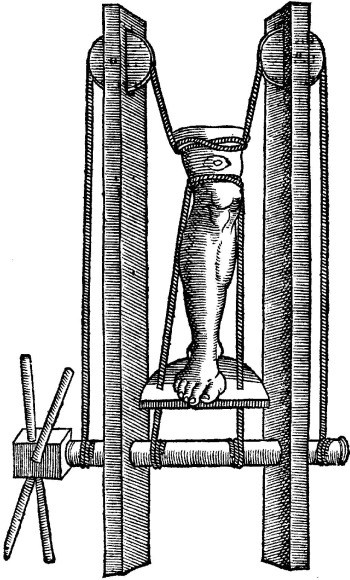
November 28, 1852 Fort Union, New Mexico Territory
My dear Mother,
Your welcome letter of October came safely to us on the 4th and found us all well, except that the swelling has not gone from my ankle. I am able to help myself up and down, but have not yet borne my weight upon the lame foot. I could sit up all the time, but my ankle is easier on the bed, so I get up in the morning and put on a wrapper, have the bed made, and sit on the outside during the day. There is no soreness in my limb or in the joint, but the swelling is great and the cords are somewhat stiff from disuse. Time no doubt will make it strong and of its natural size. The surgeon says that he could benefit it very much if he had leeches, but none are furnished this department and none are to be found in the country. It does not pain me at all, except when bandages are too tight, and that is always remedied by sending for the doctor to come and do it over. I have received every attention from Doctor Byrne and feel great confidence in him. Moreover, he is a bachelor and very agreeable, making his visits pleasant. Your affectionate daughter, Katie
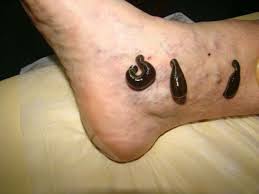
March 29, 1853 Fort Union, New Mexico Territory
My dear Mother,
I suppose you are anxious to know how my lameness is. I can walk about the house without getting very tired or limping much, but the ankle joint is very weak, and the swelling bad when I stand on it much. It never pains me, but gets stiff when I exercise too much. I have kept it bandaged constantly until within a few days. The flesh got so sore with the pressure of the bandage that I was forced to leave it off, and of course it is much weaker without the support of the cloth. I soak it every night in hot water, and keep quiet all that I can, but when at its largest, it measures three inches more than the well one. During the night the swelling subsides very much, but I must stir a little to keep the house going.
Saturday, April 2nd – Doctor Byrne has gone away on a court and a citizen doctor is sent here from Santa Fe. He is an elderly gentleman and has family in Wisconsin. He says that he has had great practice with sprained and broken bones, and assures me that he can cure mine. Tomorrow morning, I am to commence showering it, a little at a time, and bandage it, keeping the bandage moist with cold water. After a week he thinks I can bear a quart of cold water, morning and evening, and to continue increasing if no bad symptoms arise. As the trouble is not in the joint, I have great hopes. He says the swelling is almost entirely of water and that the vessels will gradually absorb this fluid, and the insensible perspiration will throw it off. In the meantime, I am to be as quiet as possible, but can move about the house, but not walk much on the ground. His name is Dr. O.W. Blanchard.
July 1, 1853 Fort Union, New Mexico Territory
My ankle is gaining and now I am able to wear a boot. The cold showering undoubtedly did it a great deal of good, but since I have left off the bandage, I have rubbed it hard every night in hot salt and vinegar and can feel that it gained strength every day. Of course, it is much larger than is natural, but I hope to reduce it in time. The foot is not much different from what it ever was, but the boots I wore last year are rather snug, so I am going to make some of brown Holland and get some man in one of the companies to sole them for me. It is now much better than I ever hoped to have it, and I do not feel like complaining if it is never better, but like you, I am always hoping, and at present have every prospect of a perfect recovery.
February 5, 1856 New Orleans, Louisiana
My dear Mother,
You will be very glad to hear that an old Frenchman here, who is celebrated for bone setting, has undertaken to cure my ankle. I have been using his liniment for a week and he comes occasionally to rub or twist the bones, looking all the while very sage, and says, “bien, bien,” meaning well, well, or good, good, and I have great hopes.
October 5, 1856 Buffalo, New York
My dear Mother,
My leg continues to improve and I bandage it every day and take it off at night. Please ask the doctor in Houlton when I am to wear the plaster bandage. We are using no wash now, as we have sent to him for the bark he ordered us to boil. There is none in any of the apothecary stores here and they say they never heard of juniper bark, nor is it set down in their lists of medicine.
January 7, 1857 New Orleans, Louisiana
I go out every fair day and must have walked three or four miles yesterday. My leg was some swollen when I took the bandage off, but I felt no pain nor experienced any weakness from the exercise. I want to know what the doctor says about my medicine and the use of the pepper wash and the juniper.
Fun Facts on Fractures
A significant percentage of bone fractures occur because of high force impact (falls and other accidents) or stress fractures (e.g., sports injuries).
There are a number of different types of fractures, including avulsion (a skin tear), comminuted (broken into more than two pieces), compound (injury to overlying skin), and hairline fractures (a small crack or severe bruise within a bone).
Bone healing is a natural process and treatment revolves around giving the bone optimum conditions to heal itself.
Signs and Symptoms of Fractures
The signs and symptoms of a fracture vary according to which bone is affected, the patient’s age and general health, as well as the severity of the injury. However, they often include some of the following:
- pain
- swelling
- bruising
- discolored skin around the affected area
- angulation – the affected area may be bent at an unusual angle
- the patient is unable to put weight on the injured area
- the patient cannot move the affected area
- the affected bone or joint may have a grating sensation
- if it is an open fracture, there may be bleeding
Medical Intervention and Treatment
If possible, do not move a person with a broken bone until a healthcare professional is present and can assess the situation and, if required, apply a splint. If the patient is in a dangerous place, one sometimes has to act before the emergency services arrive.
Medical intervention focuses on supporting the bone as it heals naturally.
Bone healing is a natural process which, in most cases, will occur automatically. Fracture treatment is usually aimed at making sure there is the best possible function of the injured part after healing.
Treatment also focuses on providing the injured bone with the best circumstances for optimum healing (immobilization).
For the natural healing process to begin, the ends of the broken bone need to be lined up – this is known as reducing the fracture.
The patient is usually asleep under a general anesthetic when fracture reduction is done. Fracture reduction may be done by manipulation, closed reduction (pulling the bone fragments), or surgery.
As soon as the bones are aligned, they must stay aligned while they heal. This may include:
- Plaster casts or plastic functional braces – these hold the bone in position until it has healed.
- Metal plates and screws – current procedures may use minimally invasive techniques.
- Intra-medullary nails – internal metal rods are placed down the center of long bones. Flexible wires may be used in children.
- External fixators – these may be made of metal or carbon fiber; they have steel pins that go into the bone directly through the skin. They are a type of scaffolding outside the body.
Usually, the fractured bone area is immobilized for 2-8 weeks. The duration depends on which bone is affected and whether there are any complications, such as a blood supply problem or an infection.
Healing and Post-Healing
If a broken bone has been aligned properly and kept immobile, the healing process is usually straightforward.
Osteoclasts (bone cells) absorb old and damaged bone while osteoblasts (other bone cells) are used to create new bone.
Callus is new bone that forms around a fracture. It forms on either side of the fracture and grows toward each end until the fracture gap is filled. Eventually, the excess bone smooths off and the bone is as it was before.
The patient’s age, which bone is affected, the type of fracture, as well as the patient’s general health are all factors which influence how rapidly the bone heals. If the patient smokes regularly, the healing process will take longer.
Physical therapy – after the bone has healed, it may be necessary to restore muscle strength as well as mobility to the affected area. If the fracture occurred near or through a joint, there is a risk of permanent stiffness or arthritis. The individual may not be able to bend that joint as well as before.
Surgery – if there was damage to the skin and soft tissue around the affected bone or joint, plastic surgery may be required.
Closer to Home
I was inspired to research broken bones both by Katie’s story of breaking her left leg and severely spraining her ankle, which left her with a life-long limp, and my grown son’s recent displaced fracture of his wrist. A displaced fracture is when the bone snaps into two or more parts and moves so that the two ends are not lined up straight. If the bone is in many pieces, it’s called a comminuted fracture. In his case, it’s called a distal radius fracture (broken wrist). The radius is the larger of the two bones of the forearm. The end toward the wrist is called the distal end. A fracture of the distal radius occurs when the area of the radius near the wrist breaks. Actually, distal radius fractures are very common. In fact, the radius is the most commonly broken bone in the arm.
A distal radius fracture almost always occurs about 1 inch from the end of the bone. The break can occur in many different ways, however.
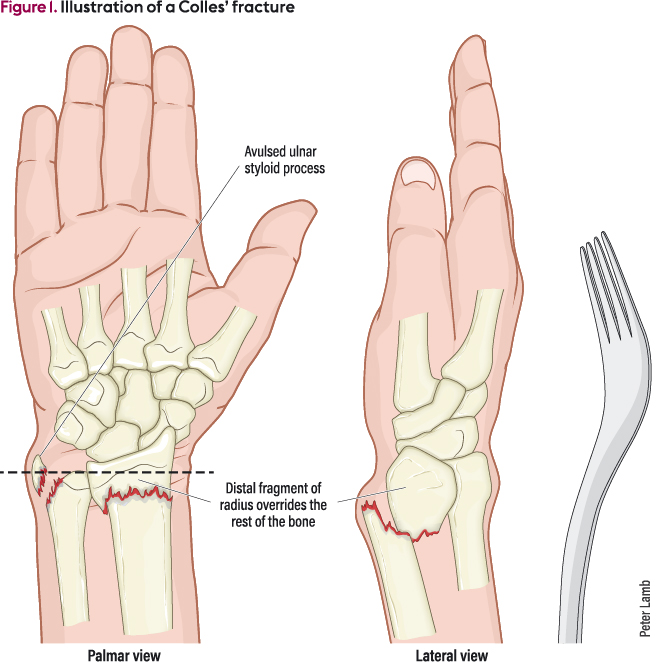
Rehabilitation and Long-term Outcomes
Most people do return to all their former activities after a distal radius fracture. The nature of the injury, the kind of treatment received, and the body’s response to the treatment all have an impact, so the answer is different for each individual. Recovery should be expected to take at least a year. Some pain with vigorous activities may be expected for the first year. Some residual stiffness or ache is to be expected for 2 years or possibly permanently; however, the stiffness is usually minor and may not affect the overall function of the arm.
What are my son’s silver linings? Those remain to be seen, but probably, similar to Katie Bowen’s. She became more patient with the healing process, followed through with medical recommendations, and demonstrated to her children how to overcome adversity. While healing, my son will continue to pass on his fascination with science and the arts to his own son. “The arts” includes, but is not limited to, music (instrumental and vocal), drawing, creative writing, designing, building furniture, and fabricating. He’s also a gifted musician and what they now call a “maker.” He’ll be fine and certainly more cautious when playing with the kids!
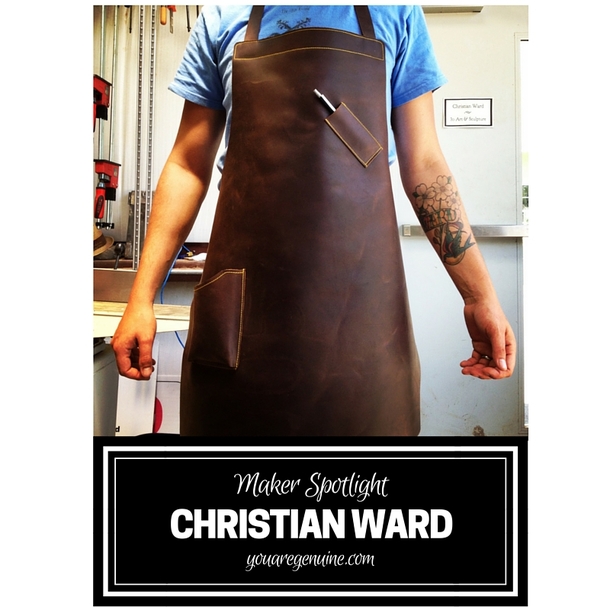
My book, Lifelines – The Bowen Love Letters, is currently available on Amazon.com, Dorrance Publishing Bookstore, and The Last Chance Store of the Santa Fe Trail Association:
https://www.amazon.com/Lifelines-Letters-Susan-Lee-Ward/
http://bookstore.dorrancepublishing.com/lifelines-the-bowen-love-letters/
https://www.lastchancestore.org/lifelines-the-bowen-love-letters/
For comments or question, feel free to send a message to susanward1231@gmail.com.
